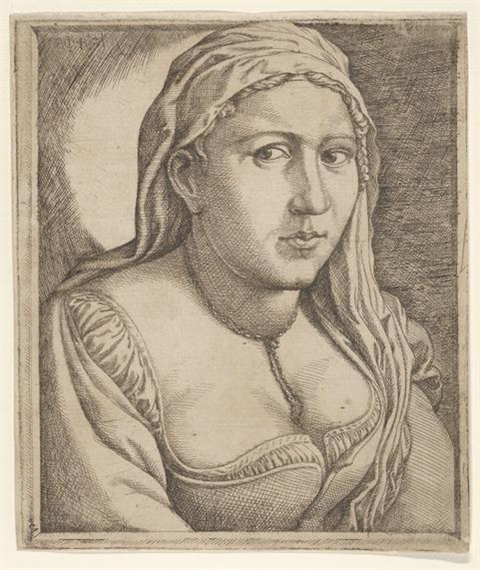Drawings and Prints
In honor of spring, this exhibition features a selection of works on paper that use the color green in their compositions, including a pastel of a ballerina by Edgar Degas, a colorful pochoir design with butterflies by E. A. Séguy, and a lithograph depicting emerald-toned squares by Josef Albers. Design books and color printing manuals that demonstrate how various shades of green have been used historically for both practical and aesthetic applications will also be featured. Finally, a selection of Neo-Impressionist prints and drawings features works by Paul Signac, Camille Pissarro, and Henri-Edmond Cross. A highlight is Signac's vibrant playbill for the Théâtre-Libre, in which he melds color theory, visual whimsy, and bold graphic design.
A selection of prints by Rembrandt van Rijn shows the artist's influence on later printmakers including the eighteenth-century Captain William Baillie, who added lightning bolts to his rendition of Rembrandt's Landscape with Three Trees and the little-known German Expressionist, Otto Lange, whose bold interpretation of the Crucifixion was inspired by Rembrandt's Three Crosses. An engaging and detailed self-portrait by Henri Matisse inspired by the Dutch master may surprise those familiar with his later colorful and freely drawn works. Another bay in the exhibition features a group of images of single figures who turn their backs to the viewer. A number of recently acquired sixteenth-century prints of figures are highlighted on another wall. They include two striking woodcuts depicting women playing the flute and the portative organ by an anonymous sixteenth-century French printmaker, a lively portrait of Cosimo I de' Medici in armor by Niccoló della Casa after Baccio Bandinelli, and the arresting portrait Woman with a Veil–The Wife of the Artist by Jan Vermeyen, shown at left.
Several sections feature recently acquired French drawings. A selection of Rococo works includes Jean Jacques François Le Barbier's frenetic bacchanal set in a verdant glade among ancient ruins and Louis Jean Jacques Durameau's Juno Ordering Aeolus to Unleash the Winds, a painterly evocation of a scene from Virgil's Aeneid, where the vengeful goddess urges Aeolus to unleash the winds, hoping to destroy Aeneas's fleet. The topographical interests of landscape artists of the period are represented in Jean Antoine Constantin's distant view of his native city, Aix-en-Provence, and Louis François Cassas' View of Messina Harbor, an impressive rendering of the elegant architecture of the city's waterfront before it was destroyed by earthquake. A grouping focused on the urban design of the French capital during the Napoleonic period includes a number of interesting watercolors by Pierre François Léonard Fontaine, the leading architect of the time.

Recommended for you
In honor of spring, this exhibition features a selection of works on paper that use the color green in their compositions, including a pastel of a ballerina by Edgar Degas, a colorful pochoir design with butterflies by E. A. Séguy, and a lithograph depicting emerald-toned squares by Josef Albers. Design books and color printing manuals that demonstrate how various shades of green have been used historically for both practical and aesthetic applications will also be featured. Finally, a selection of Neo-Impressionist prints and drawings features works by Paul Signac, Camille Pissarro, and Henri-Edmond Cross. A highlight is Signac's vibrant playbill for the Théâtre-Libre, in which he melds color theory, visual whimsy, and bold graphic design.
A selection of prints by Rembrandt van Rijn shows the artist's influence on later printmakers including the eighteenth-century Captain William Baillie, who added lightning bolts to his rendition of Rembrandt's Landscape with Three Trees and the little-known German Expressionist, Otto Lange, whose bold interpretation of the Crucifixion was inspired by Rembrandt's Three Crosses. An engaging and detailed self-portrait by Henri Matisse inspired by the Dutch master may surprise those familiar with his later colorful and freely drawn works. Another bay in the exhibition features a group of images of single figures who turn their backs to the viewer. A number of recently acquired sixteenth-century prints of figures are highlighted on another wall. They include two striking woodcuts depicting women playing the flute and the portative organ by an anonymous sixteenth-century French printmaker, a lively portrait of Cosimo I de' Medici in armor by Niccoló della Casa after Baccio Bandinelli, and the arresting portrait Woman with a Veil–The Wife of the Artist by Jan Vermeyen, shown at left.
Several sections feature recently acquired French drawings. A selection of Rococo works includes Jean Jacques François Le Barbier's frenetic bacchanal set in a verdant glade among ancient ruins and Louis Jean Jacques Durameau's Juno Ordering Aeolus to Unleash the Winds, a painterly evocation of a scene from Virgil's Aeneid, where the vengeful goddess urges Aeolus to unleash the winds, hoping to destroy Aeneas's fleet. The topographical interests of landscape artists of the period are represented in Jean Antoine Constantin's distant view of his native city, Aix-en-Provence, and Louis François Cassas' View of Messina Harbor, an impressive rendering of the elegant architecture of the city's waterfront before it was destroyed by earthquake. A grouping focused on the urban design of the French capital during the Napoleonic period includes a number of interesting watercolors by Pierre François Léonard Fontaine, the leading architect of the time.
Contact details


 ARTISTS
ARTISTS












